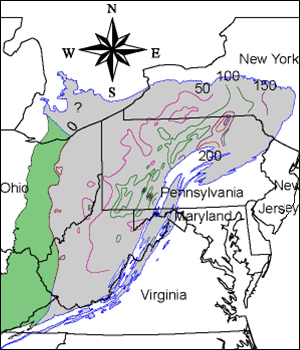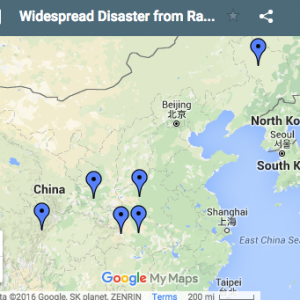EPA Announces Study to Re-Examine the Health Risks of Hydrofracking
As the federal agency launches its newest study, states are implementing stricter regulatory standards for hydro-fracking.
The U.S. Environmental Protection Agency has announced a $1.9 million study that will re-examine a controversial drilling technique used to free natural gas, the AP reports.

The EPA’s decision comes as corporate interest increases in the Marcellus Shale region—95,000 square miles of dense rock beneath the Pennsylvania New York, West Virginia and Ohio that contains enough natural gas to supply the East Coast for a half century.
Roughly 90 percent of the 450,000 gas wells in the U.S. use hydraulic fracturing—a process that uses large amounts of pressurized water mixed with chemicals to fracture land to extract fossil fuels located deep underground. Commonly referred to as “fracking,” it requires a mixture of water and toxic chemicals that some fear could potentially pollute water sources. Additionally, aquifer depletion concerns have cropped up given that the average frack uses 4 million gallons of water.
In 2005 Congress ruled that fracking didn’t need to be regulated by the federal government.
But the EPA’s announcement comes off the heels of Pennsylvania’s decision to finalize standards that will help regulate fracking in the state. In response to fish kills, building corrosion, natural gas explosions and consumer complaints about water from natural gas drilling in the region, the state’s Department of Environmental Protection has ruled to monitor total dissolved solids (TDS) for the first time. TDS are a compilation of the organic and inorganic material found in liquids that can come from surface runoff.
Pennsylvania has implemented stricter standards on natural gas drilling because high levels of TDS, including sulfides and chlorides, were found in the wastewater left over from the drilling process. Abandoned coal mines in both Pennsylvania and West Virginia have added high levels of sulfates to the water, according to DEP spokesman, William Rathbun.
“We discovered that during low water and drought that the rivers were getting overwhelmed with high levels of salts chlorides and sulfates,” Rathbun said.
These contaminants can lead to health risks as well as higher operational and maintenance costs.
Earlier this month, cows that had allegedly consumed toxic wastewater from natural gas drilling were pulled off the food market from a farm in northern Pennsylvania, Reuters reports.
“Wastewater treatment plants were not equipped to treat for it because they had never been required to before,” Rathbun said. As a result, contamination consequences have slipped through the cracks, unmonitored.
One of the accusations has been that drilling companies do not come forth with the chemicals that are being used during fracking.
Pennsylvania state law requires that companies provide the names of chemicals they are using on site.
Other states are also calling for more public transparency. Wyoming’s Oil and Gas Conservation Commission approved rules last month that require companies to make public a list of chemicals used in the fracking. Meanwhile Colorado passed a similar requirements last year, reports The Daily Sentinel.
Meanwhile the DEP has released a list of 80 chemicals that are brought to the well site where the fracking process takes place. A second list of chemicals that are actually used in the process are set to be released this month.
“It is critical that we implement a strong discharge standard for wastewater that does make it into our water supply,” Pennsylvania House Representative David Levdansky, told the Pittsburgh Post-Gazzette.”
“Hydrofracking has never been conducted on such a scale and with such volumes of water in our state before,” Levdansky said.
“Drilling wastewater contains TDS levels that are thousands of times more harmful to aquatic life than discharges from other industries. Without imposing limits on this pollution, treatment costs for this wastewater are passed along to downstream industries and municipal ratepayers,” Environmental Protection Secretary John Hanger told The Empowered Municipality, A Pennsylvania based organization connecting municipal decisionmakers and suppliers.
In addition to pollution concerns, there have been recent disasters from the Marcellus Shale drilling pads.
Early last month, a drilling pad exploded in Clearfield County, a rural area of northern Pennsylvania, with gas and contaminated water shooting up to 75 feet in the air for 16 hours, according to theAP.
Four days later a natural gas explosion injured seven crew members in Moundsville, West Virginia, which sits near the state’s border with Ohio and Pennsylvania, reports the Pittsburgh Post-Gazette.
There were two specific events that inspired the DEP to established, the Environmental Quality Board, the panel was established to investigate chemicals released in the fracking process. It took one year to implement the new TDS requirements.
Earlier this year the Upper Delaware River was deemed the most endangered river in the U.S. by American Rivers, a leading national conservation non-profit, because of threats from natural gas drilling. Much of the Marcellus Shale formation resides in the Delaware River Basin.









Leave a Reply
Want to join the discussion?Feel free to contribute!